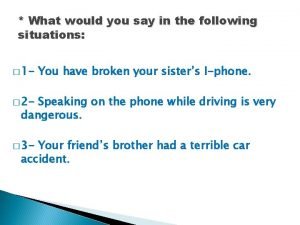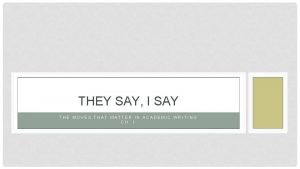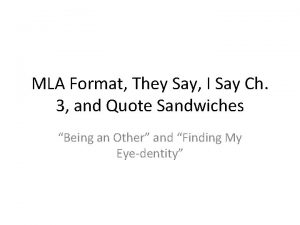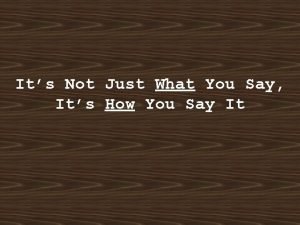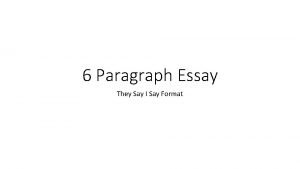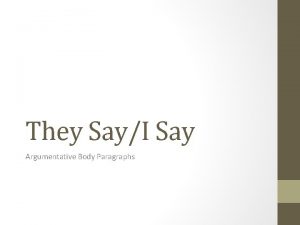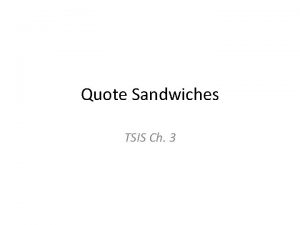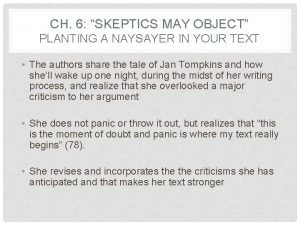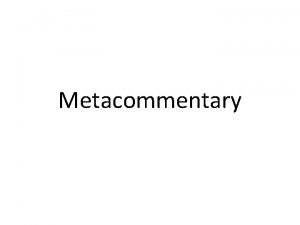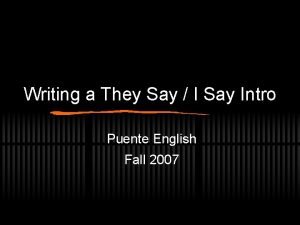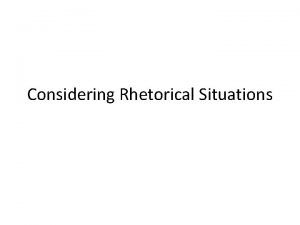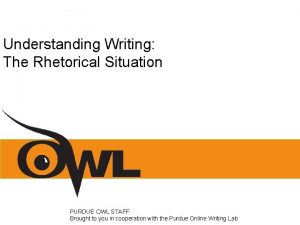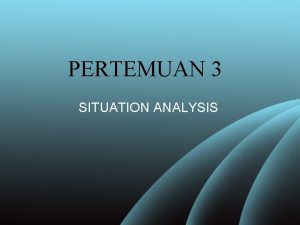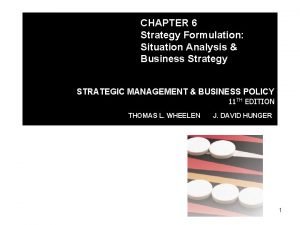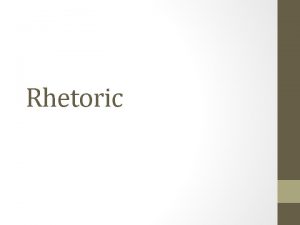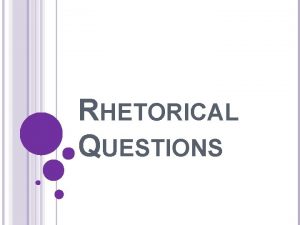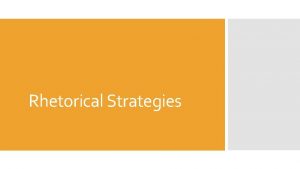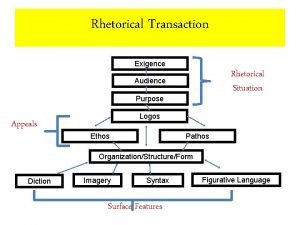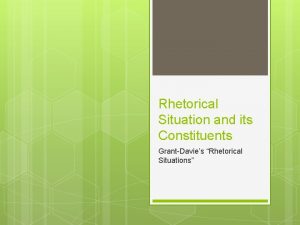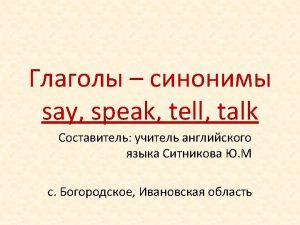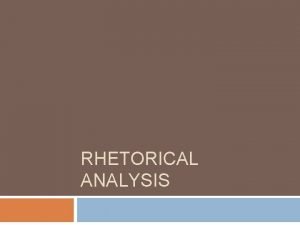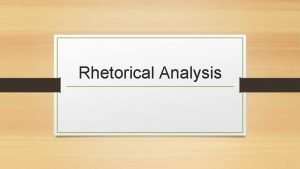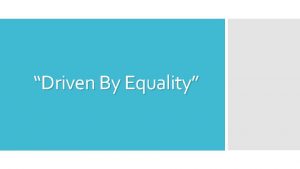Rhetorical situation Rhetorical analysis what texts say how






























- Slides: 30

• Rhetorical situation • Rhetorical analysis: what texts say, how they work, and what they do. • PACES – a broad framework for thinking about argument, esp. academic argument. We will use this a lot as a lens for analyzing texts. • Analysis of context and evaluation of strengths and weaknesses


Audience

Genre • This image lacks genre, and thus its purpose, context and intended audience are hard to discern

GENRE • Genre tells you a lot about a text – its intended audience, who the writer is, the context, purpose etc. • It supplies much of the information needed to interpret this image.

The power of context Students used to salute the flag when reciting the pledge of allegiance. This changed after WWII.

Putting students through their P. A. C. E. S (p. 12, reader) • • • Purpose/project Argument Claims Evidence Strategies (argument is like building, claims are like key supports, evidence helps support claims, and strategies are the design)

• All of these categories can be broken down into smaller and smaller subcategories, providing a comprehensive way of mapping reasoning and argumentation. • Once we have mapped out and “unpacked” the various aspects of argument, we can then draw upon a set of criteria for evaluating them.

Example: rebuttals • A common strategy is the rebuttal (inoculation, anticipation, fair-mindedness, contrast, etc. ) • There are many types of rebuttal. Three of the most common types are the “strategic concession, ” the “refutation, ” and the “demonstration of irrelevance. ” • Once we’ve identified the form of rebuttal, we can look at different kinds & evaluate:

EVALUATING REFUTATION

Evidence • Types of evidence (examples, anecdotes, experience, testimony, historical information, statistics, etc. ) • Uses of evidence and issues of context, purpose, audience (validity and effectiveness) • Criteria for evaluating evidence • Sufficiency, typicality, accuracy, relevance (STAR) • Verifiability, scope, date, quality, “fit, ” etc.

• Example: Jon Stewart identifies 5 claims by Keith Olbermann in his attack on Brown (the newly elected republican senator from Massachusetts. ) Stewart analyzes the evidence supporting each claim. • http: //www. thedailyshow. com/watch/thujanuary-21 -2010/special-comment---keitholbermann-s-name-calling

Strategies • Rhetorical Strategy: a particular way in which authors craft language so as to have an effect on readers. Strategies are means of persuasion, ways of gaining a readers’ attention, interest, or agreement. Strategies can be identified in the way an author organizes her text, selects evidence, addresses the reader, frames an issue, presents a definition, constructs a persona or establishes credibility, appeals to authority, deals with opposing views, uses “meta-discourse, ” makes particular use of style and tone, draws on particular tropes and images, as well as many of the other textual choices that can be identified. • Common strategies: ethos, pathos, logos, framing, definitions, categories, word choice, style as strategy, rebuttals, metadiscourse, organization, tropes, etc.

Ethos, pathos, logos • "Ethos" refers to the writer's "ethical appeal, " that is, how well the writer presents herself. Does she seem knowledgeable and reasonable? Does she seem trustworthy? Does she seem credible? Ethos can be divided into two parts: authority (credibility) and character (trustworthiness). You may find an argument unpersuasive even if they claims and reasons are strong, if the speaker has poor ethos. • "Pathos" refers to the argument's "emotional appeals, " that is, how well the writer taps into the reader's emotions. Many times, this appeal is how a writer will make an argument "matter" to readers. Advertisements do it all the time. Perhaps a writer will offer an anecdote to illustrate suffering or appeal to readers as parents concerned for their children. Does the writer appeal to your emotions —feelings of sadness, pride, fear, being young, anger, patriotism, love, justice?

• "Logos" corresponds with the argument's "logical appeals. Effective arguments will probably include facts and other supporting details to back up the author's claims. They may contain testimony from authorities and will demonstrate the writer's carefulness in choosing and considering evidence. Questions to consider: What is being argued here, or what is the author's thesis? What points does she offer to support this idea? Has she presented arguments that seem logical, or does she seem to be jumping to conclusions?

• A BALANCE of the three, ethos, pathos, logos, is often important (although as always, context and audience are crucial). Too much of one may produce an argument that readers will either find unconvincing or that will cause them to stop reading. • Each appeal potentially affects the others. An overwhelming emotional argument may make us feel that the author is relying exclusively on emotions rather than offering solid reasoning. An argument contains only facts and figures and no emotional appeals, we may simply get bored. All these defects may, in turn, affect the author's ethical appeal: how can we trust a writer who appeals only to our emotions? What common ground do we have with a writer who doesn't appeal to our emotions at all? • Research in cognitive psychology, animal behavior, neurophysiology, an other fields suggests that morality, values and emotion play a big part in how we reason. See it in Damasio studies of people who lose ability to feel emotion or morals – makes it hard to make decision (rather than Spock-like ability to efficiently decide on things). Human nature is back in vogue. • SPOCK, KIRK AND COMMANDER PIKE – reason, passion and authority

Ethos, pathos, logos & Star Trek • Logos, Pathos Ethos Pike is ethos - Kirk won’t listen to any authority figures, in fact he delights in rebelling against all authority figures. But Pike represents a particularly credible, authentic form of ethos. He is noble, brave, & self-sacrificing. He appeals to Kirk’s sense of duty, desire to serve a larger cause and challenges him to live up to his father’s example.

Ethos, pathos & logos in TNG

Analyzing Kristof • What is the rhetorical situation (context, genre, publication, audience, purpose)? • Argument? • Main claims? • Evidence? • Strategies? (Example: ethos, pathos, logos; rebuttals; analogies, word choice, frames, etc. )

Analyzing Kristof • What are some strengths and weaknesses of Kristof’s argument? • Macro-charting: What is Kristof “doing” in pars 1 -7, 8 -10, 12 -19, 20?

• Some occupations come with an expected ethos. There is a kind of institutional persona – ways of talking, dressing, and values we expect to encounter. For example – while we may expect a stockbroker to be all about chasing profit, to be entrepreneurial, brash, etc. , we might not expect this from a doctor. • What sort of ethos do we expect from a doctor? What qualities of character do we expect? • The TV show Scrubs creates comedy by subverting the expectations we have about the ethos of a doctor. Example: Cole, a student at Winston University Medical School, talking to his teacher http: //www. youtube. com/watch? v=CZVwej. Bhp. Rs

Anti Smoking Ads • As part of a legal settlement, tobacco companies like Phillip Morris were forced to produce ads aimed at persuading kids not to smoke. Critics contend that these ads are often weak, and were subtly designed to be ineffective. • What would you do if you were tasked with producing ads for Phillip Morris – what ad would you create? Think about the rhetorical situation – who is your audience? What is your purpose? What strategies might you use?

• Examine these 4 ads – which do you think is likely by Philip Morris? Which is most/least effective?

• A) “Hooked”

b) “Joe Chemo, ” & c) “Don’t wipe out”

4. “Throaty Mc. Throatington”

• PSAs – too much logos, wrong kind of pathos & not enough rhetorical savvy - e. g. Anti Smoking Ads. • Government sponsored public service ad campaigns have struggled to be persuasive, especially those directed at smoking, drug taking, and safety. • However, a British ad campaign directed at young smokers was very effective. Here is an example of one of the ads:

• Ads that work use the strategy of “social rejection” and fear of being uncool. Many 14 year olds aren’t afraid of long term health risks, throat cancer or wrinkles – but they are often terrified of seeming uncool, facing ostracism or questions regarding sexual adequacy. ■ Text reads: “Did you know there’s A valve in your penis that traps blood inside so you can get an erection? That every time you smoke this valve is damaged? That if you don’t quit now, it might stop working altogether? You do now. ” Text HARD to 84118 for a free Information pack. www. stayinghard. info

Anti smoking campaigns show poor understanding of rhetoric • “Some anti-smoking ads are simply ineffective, while others actually make youth more likely to light up. ” (rebel sell) • One study found that anti-smoking ads that stress long-term health effects or cosmetic issues are not effective. • Recent research suggest that successful ads work “by enhancing perceptions that smoking poses severe social rejection risks. Other messages increased health risk severity perceptions, but such perceptions either had null or counterproductive effects on nonsmoking intentions, due to adolescents' perceived invulnerability to health risks. ” (Pechmann, C. , G. Zhao, M. E. Goldberg and E. T. Reibling (2003), "What to Convey in Antismoking Advertisements for Adolescents? The Use of Protection Motivation Theory to Identify Effective Message Themes, " Journal of Marketing, 67 (April), 1 -18.

• “You get a lot to like: filter, flavor, flip top box • "MARLBORO: THE FILTER CIGARETTE IN THE FLIPTOP BOX" • Small Print: "You get the mansize flavor of honest tobacco without huffing and puffing. This filter works good and draws easy. The Flip-Top Box keeps every cigarette in good shape. You'd expect it to cost more, but it doesn't. "
 Rhetorical situation analysis
Rhetorical situation analysis What will you say in the following situations
What will you say in the following situations They say / i say paragraph examples
They say / i say paragraph examples Metacommentary meaning
Metacommentary meaning They say i say gerald graff summary
They say i say gerald graff summary They say i say chapter 3
They say i say chapter 3 It's not what you say it's how you say it
It's not what you say it's how you say it 6 paragraph essay
6 paragraph essay They say / i say paragraph examples
They say / i say paragraph examples What are voice markers they say i say
What are voice markers they say i say They say i say chapters
They say i say chapters Quote sandwich examples
Quote sandwich examples Skeptics may object summary
Skeptics may object summary They say i say moves that matter in academic writing
They say i say moves that matter in academic writing Say sistemi
Say sistemi They say i say chapter 10
They say i say chapter 10 How do you say puente in english
How do you say puente in english Some say the world will end in fire some say in ice
Some say the world will end in fire some say in ice Some say the world will end in fire some say in ice
Some say the world will end in fire some say in ice What do you say after you say hello download
What do you say after you say hello download They say i say
They say i say Rhetorical modes meaning
Rhetorical modes meaning Definition of rhetorical situation
Definition of rhetorical situation Genre and rhetorical situation
Genre and rhetorical situation Rhetorical analysis purdue owl
Rhetorical analysis purdue owl Situation analysis adalah
Situation analysis adalah Difference between target needs and learning needs
Difference between target needs and learning needs The role of context in discourse analysis slideshare
The role of context in discourse analysis slideshare Contoh situation analysis
Contoh situation analysis Strategic situation analysis adalah
Strategic situation analysis adalah Strategic situation analysis adalah
Strategic situation analysis adalah

